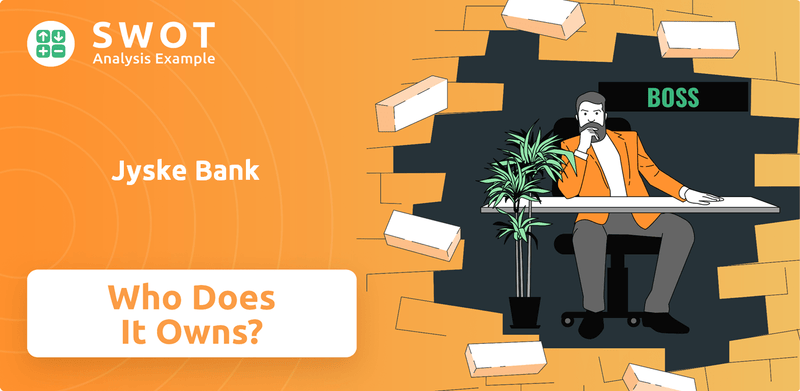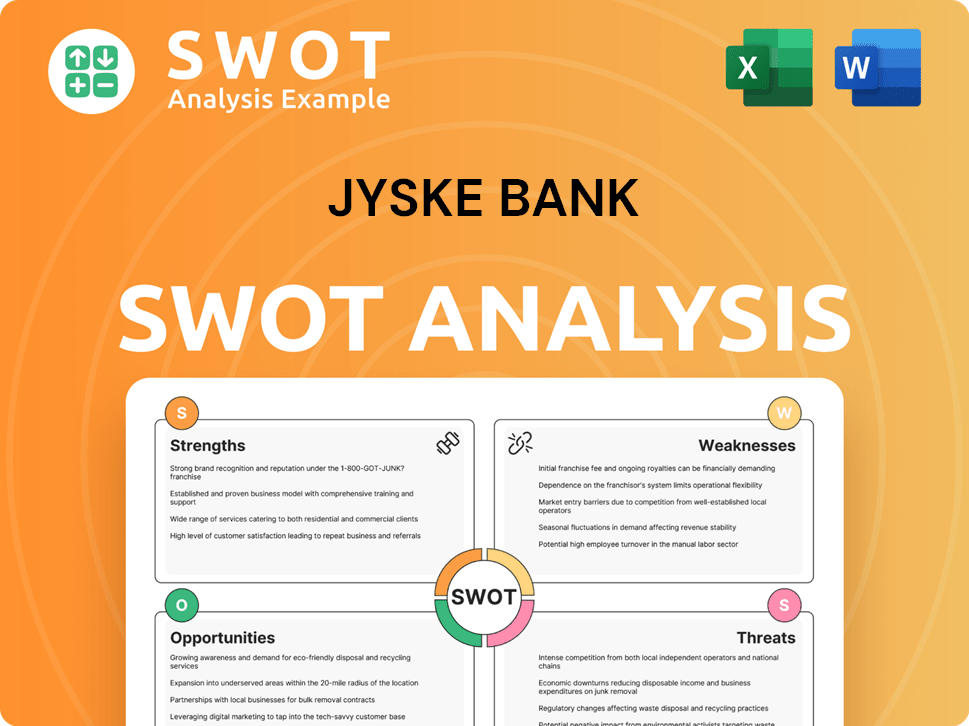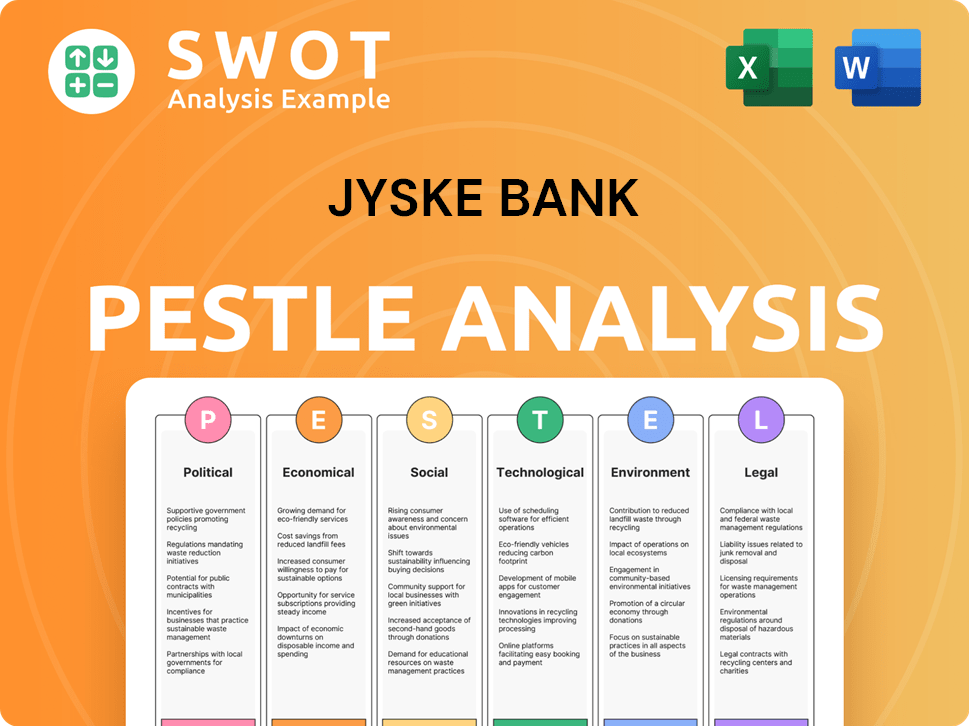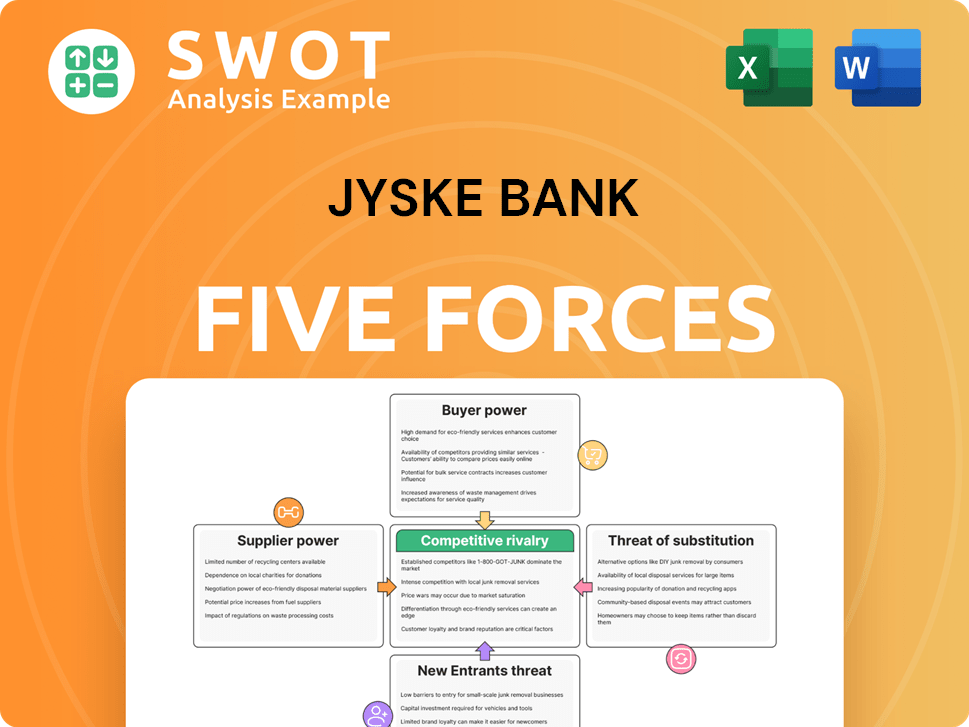Jyske Bank Bundle
Who Really Owns Jyske Bank?
Unveiling the ownership structure of Jyske Bank is key to understanding its trajectory in the dynamic financial landscape. The evolution of ownership, especially during pivotal moments like acquisitions or shifts in shareholding, can significantly impact a company's future. Founded in 1967, Jyske Bank has grown into a major player in the Danish banking sector, and understanding its ownership is crucial.

This analysis of Jyske Bank SWOT Analysis will explore the bank's ownership, from its humble beginnings to its current shareholder base. We'll examine the influence of major stakeholders, including institutional investors and public shareholders, on strategic decisions and governance. Understanding the answers to questions like "Who owns Jyske Bank?" and "Who controls Jyske Bank?" is vital for investors and anyone interested in the bank's long-term prospects. Delving into Jyske Bank's ownership structure provides critical insights for financial professionals and investors alike, revealing the forces shaping this significant Danish bank.
Who Founded Jyske Bank?
The formation of Jyske Bank on July 7, 1967, marked the beginning of a significant entity in the Danish banking sector. This establishment was the result of a merger among four local banks located in Central Jutland: Silkeborg Bank, Kjellerup Bank, Kjellerup Handels- & Landbrugsbank, and Handels- & Landbrugsbanken i Silkeborg. This strategic consolidation was aimed at enhancing their competitive position in the financial market.
Poul Norup, who previously served as the Managing Director of Silkeborg Bank, was appointed as Jyske Bank's first CEO. He led the bank until his retirement in 1989. Under his leadership, Jyske Bank experienced substantial growth, evolving from Denmark's 18th largest bank with only eight branches and 163 employees to a nationwide institution. By the end of his tenure, the bank had expanded to 152 branches within Denmark and five international locations, with a workforce exceeding 3,000 employees.
Early ownership developments included the addition of Banken for Brædstrup og Omegn in 1968, which initially failed to secure the required majority for a merger. Another key move was the acquisition of Jysk Diskonteringsselskab, which focused on car financing. Jyske Bank initially purchased a 10% stake for DKK 5 million and later acquired the remaining share capital in 1984, renaming it Jyske Finans. While specific details on the equity splits or shareholdings of the founders during the initial stages are not publicly available, these mergers and strategic investments shaped the bank's early structure, reflecting its vision for expansion and service diversification.
The early years of Jyske Bank were defined by strategic mergers and acquisitions that shaped its ownership and operational structure. These moves were crucial for expanding its reach and service offerings.
- The initial merger of four local banks in 1967 formed the foundation of Jyske Bank.
- The acquisition of Banken for Brædstrup og Omegn in 1968 expanded its reach.
- The investment in Jysk Diskonteringsselskab, later renamed Jyske Finans, diversified its financial services.
- Poul Norup's leadership saw significant growth, transforming Jyske Bank into a major player.
Jyske Bank SWOT Analysis
- Complete SWOT Breakdown
- Fully Customizable
- Editable in Excel & Word
- Professional Formatting
- Investor-Ready Format

How Has Jyske Bank’s Ownership Changed Over Time?
The ownership structure of Jyske Bank has evolved since its initial public offering (IPO) on the Copenhagen Stock Exchange on October 3, 2004. As of April 17, 2025, the bank's market capitalization is approximately DKK 31.68 billion. The current ownership is primarily influenced by individual investors, who collectively hold a significant 53% stake, highlighting the broad public interest in the bank. Private companies also play a crucial role, owning a substantial 29% of the shares.
The largest single shareholder is BRFfonden A/S, which held 27.71% of the shares, equivalent to 17,809,797 shares as of December 30, 2023. Other major institutional investors include Dimensional Fund Advisors LP with 3.82% (2,313,359 shares as of April 29, 2025), The Vanguard Group, Inc. with 2.83% (1,714,122 shares as of March 30, 2025), and Norges Bank Investment Management with 2.78% (1,685,441 shares as of June 29, 2024). BlackRock, Inc. also holds a notable stake of 1.35% (818,379 shares as of April 29, 2025). Understanding the Brief History of Jyske Bank provides further context to its ownership journey.
| Shareholder | Stake (%) | Shares (as of latest available data) |
|---|---|---|
| BRFfonden A/S | 27.71% | 17,809,797 (December 30, 2023) |
| Dimensional Fund Advisors LP | 3.82% | 2,313,359 (April 29, 2025) |
| The Vanguard Group, Inc. | 2.83% | 1,714,122 (March 30, 2025) |
| Norges Bank Investment Management | 2.78% | 1,685,441 (June 29, 2024) |
| BlackRock, Inc. | 1.35% | 818,379 (April 29, 2025) |
Key events shaping the ownership structure include the 2014 acquisition of BRFkredit A/S, which later became Jyske Realkredit A/S in 2018, and the 2022 acquisition of the Danish branch of Svenska Handelsbanken. These strategic moves have expanded Jyske Bank's service offerings and market reach, influencing its overall strategy and the expectations of its shareholders. These acquisitions and partnerships have influenced the bank's strategy by expanding its service offerings and market reach within Denmark.
Jyske Bank's ownership is primarily held by individual investors, with a significant portion also owned by private companies.
- BRFfonden A/S is the largest shareholder.
- Institutional investors like Dimensional Fund Advisors LP and The Vanguard Group, Inc. also hold substantial stakes.
- Acquisitions, such as BRFkredit A/S and the Danish branch of Svenska Handelsbanken, have shaped its ownership structure.
- Understanding the Jyske Bank ownership structure is key to understanding who controls Jyske Bank.
Jyske Bank PESTLE Analysis
- Covers All 6 PESTLE Categories
- No Research Needed – Save Hours of Work
- Built by Experts, Trusted by Consultants
- Instant Download, Ready to Use
- 100% Editable, Fully Customizable

Who Sits on Jyske Bank’s Board?
The current board of directors of Jyske Bank, a key aspect of understanding Jyske Bank ownership, is chosen through a dual process involving both the Shareholders' Representatives and the general meeting. At the Annual General Meeting held on March 25, 2025, shareholders re-elected Lisbeth Holm and Glenn Söderholm to the Supervisory Board. Birgitte Haurum was also elected, and Anker Laden-Andersen was re-elected to the Supervisory Board at a subsequent meeting of the Shareholders' Representatives. This structure ensures a balance between shareholder representation and independent oversight.
Following these elections, the Supervisory Board appointed Kurt Bligaard Pedersen as Chairman and Anker Laden-Andersen as Deputy Chairman. This leadership team is responsible for overseeing the bank's strategic direction and ensuring its operations align with the interests of its shareholders and stakeholders. Understanding the composition of the board is crucial for anyone looking into Jyske Bank shareholders and how the bank is governed.
| Board Member | Role | Election/Re-election Date |
|---|---|---|
| Lisbeth Holm | Supervisory Board Member | March 25, 2025 |
| Glenn Söderholm | Supervisory Board Member | March 25, 2025 |
| Birgitte Haurum | Supervisory Board Member | Subsequent meeting of Shareholders' Representatives |
| Anker Laden-Andersen | Deputy Chairman, Supervisory Board Member | Subsequent meeting of Shareholders' Representatives |
| Kurt Bligaard Pedersen | Chairman of the Supervisory Board | Appointed by the Supervisory Board |
Regarding voting power, the structure at Jyske Bank is generally one-share-one-vote for shares with a nominal value of DKK 10. However, a voting-right limit of 4,000 votes applies, preventing any single shareholder from controlling a disproportionate amount of votes. Resolutions to amend the Articles of Association require a high threshold of representation and approval, ensuring significant shareholder consensus on critical matters. For more insights into the financial strategies, consider reading about the Marketing Strategy of Jyske Bank.
The voting structure at Jyske Bank is designed to balance shareholder influence.
- One-share-one-vote for shares with DKK 10 nominal value.
- A voting-right limit of 4,000 votes per shareholder.
- Amendments to Articles of Association require significant shareholder approval.
- Extraordinary General Meetings may be called if representation thresholds are not met.
Jyske Bank Business Model Canvas
- Complete 9-Block Business Model Canvas
- Effortlessly Communicate Your Business Strategy
- Investor-Ready BMC Format
- 100% Editable and Customizable
- Clear and Structured Layout

What Recent Changes Have Shaped Jyske Bank’s Ownership Landscape?
In the past few years, Jyske Bank has been actively managing its capital, primarily through share buyback programs. A new program, valued at up to DKK 2.25 billion, began on February 26, 2025, and is scheduled to run until January 31, 2026. These actions are designed to adjust the bank's capital structure and provide value to its shareholders. As of June 10, 2025, Jyske Bank held 3,747,521 of its own shares, representing 5.83% of the company's share capital, a direct result of these buybacks.
In 2024, Jyske Bank completed a share buy-back program totaling DKK 1.5 billion. The bank's Supervisory Board also proposed a dividend of DKK 24 per share for 2024, equating to 30% of the shareholders' result. These moves highlight a commitment to returning capital to shareholders. These financial maneuvers and strategic decisions influence the overall Jyske Bank ownership dynamics.
| Development | Details | Impact |
|---|---|---|
| Share Buyback Program | DKK 2.25 billion, commencing February 2025, ending January 2026 | Adjusts capital structure, benefits Jyske Bank shareholders |
| 2024 Share Buyback | DKK 1.5 billion completed | Returns capital to shareholders |
| 2024 Dividend | DKK 24 per share, 30% of shareholders' result | Rewards shareholders |
Other notable developments include the successful integration of Handelsbanken Danmark and PFA Bank, which has largely been completed with better-than-expected results and synergies. Jyske Finans' acquisition of the Opendo leasing portfolio, announced in September 2024, is progressing as planned. Furthermore, the bank announced an updated strategy towards the end of 2024, focusing on cost management and investments in key customer segments. These strategic shifts are crucial for understanding who owns Jyske Bank and its future direction.
Ongoing share buyback programs demonstrate a commitment to returning value to shareholders, impacting the Jyske Bank ownership structure. These programs also reflect confidence in the bank's financial health and future prospects.
The integration of Handelsbanken Danmark and PFA Bank, along with the acquisition of the Opendo leasing portfolio, signals a strategic focus on expansion and consolidation. These actions influence the Jyske Bank parent company and its market position.
Consistent dividend payments and proposals reflect a shareholder-friendly approach, influencing investor perceptions. This also provides insights into the priorities of Jyske Bank executives and the board.
The updated strategy, emphasizing cost management and investment in key customer segments, is designed to strengthen the bank's market position. This will shape Jyske Bank's ownership and future success.
Jyske Bank Porter's Five Forces Analysis
- Covers All 5 Competitive Forces in Detail
- Structured for Consultants, Students, and Founders
- 100% Editable in Microsoft Word & Excel
- Instant Digital Download – Use Immediately
- Compatible with Mac & PC – Fully Unlocked

Related Blogs
- What are Mission Vision & Core Values of Jyske Bank Company?
- What is Competitive Landscape of Jyske Bank Company?
- What is Growth Strategy and Future Prospects of Jyske Bank Company?
- How Does Jyske Bank Company Work?
- What is Sales and Marketing Strategy of Jyske Bank Company?
- What is Brief History of Jyske Bank Company?
- What is Customer Demographics and Target Market of Jyske Bank Company?
Disclaimer
All information, articles, and product details provided on this website are for general informational and educational purposes only. We do not claim any ownership over, nor do we intend to infringe upon, any trademarks, copyrights, logos, brand names, or other intellectual property mentioned or depicted on this site. Such intellectual property remains the property of its respective owners, and any references here are made solely for identification or informational purposes, without implying any affiliation, endorsement, or partnership.
We make no representations or warranties, express or implied, regarding the accuracy, completeness, or suitability of any content or products presented. Nothing on this website should be construed as legal, tax, investment, financial, medical, or other professional advice. In addition, no part of this site—including articles or product references—constitutes a solicitation, recommendation, endorsement, advertisement, or offer to buy or sell any securities, franchises, or other financial instruments, particularly in jurisdictions where such activity would be unlawful.
All content is of a general nature and may not address the specific circumstances of any individual or entity. It is not a substitute for professional advice or services. Any actions you take based on the information provided here are strictly at your own risk. You accept full responsibility for any decisions or outcomes arising from your use of this website and agree to release us from any liability in connection with your use of, or reliance upon, the content or products found herein.